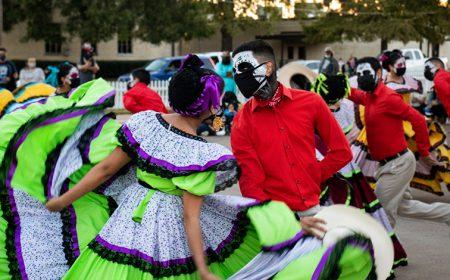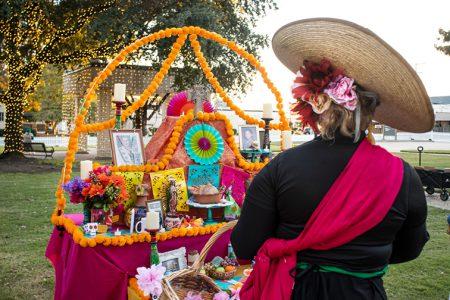Hispanic culture utilizes costumes, makeup and altars to honor deceased family members

Folklórico dancers performs outside Grand Prairie City Hall during a Day of the Dead celebration.
LINDA PUGA
campus edito
The Day of the Dead holiday continued for NE student Yaravidt Ramirez Olivas even without being able to gather with others to celebrate her deceased loved ones.
“My favorite part is the ability to dedicate time once a year to those members that are on to the next life,” Olivas said.
Remembering her lost family members has helped Olivas stay connected to her Hispanic culture, despite the current circumstances of the pandemic.
Olivas said her family usually holds a big family gathering, makes tamales and lights candles placed in front of photos of the deceased at the end of the evening.
Because the holiday is celebrated Oct. 31-Nov. 2, Olivas said her family decided to reschedule the festivities due to COVID-19.
TR student Jaime Mejia said he admires how Day of the Dead unites the Mexican community.
It doesn’t matter if you are from the North or South of Mexico, the day can still be celebrated and expressed through customs and contemporary art, Mejia said.
Preserving this holiday has become important as more countries have recognized and adopted these traditions, he said.
“I strongly believe that it is not just important to celebrate Día de los Muertos but also to be proud of embracing this ancient tradition,” Mejia said.
Mejia and his family take part in praying for the souls to be resting in peace on Nov. 2.
South student Fatima Albarran admires that the holiday commemorates life.
“My favorite aspect of Día de los Muertos is that instead of completely mourning lost ones, those who celebrate it can remember and celebrate their spirit as if they were truly alive,” Albarran said.
She sees importance in this holiday because of its origin and purpose.
“The Aztecs believed that the dead would be insulted by sadness, so instead their life is celebrated, and their spirit can come back to join their family through traditions they would already do if they were alive,” Albarran said.
Preserving this belief is a big part of the culture to ensure lost loved ones still feel remembered, she said. Albarran and her family only celebrate the holiday with the original traditions when they are in Mexico.
“We go to festivals where everyone eats and does activities the deceased would have loved,” Albarran said. “I would love to celebrate it more here than I do.”
However, she said her family still finds a way to incorporate those traditions even from their home in Fort Worth.
“The thing we do every year when we are not in Mexico is set up an altar with all of our deceased loved ones with a candle by their picture to bring back their spirit while we bring positive vibes through eating and drinking food and drinks such as Mexican sweetbread, mole, hot chocolate and atole,” Albarran said.



dead.

folk culture with ballet characteristics.

























